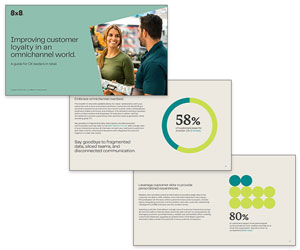We introduce a number of key considerations for contact centre benchmarking, which will help you draw greater insight from your metrics.
Benchmark Your Metrics Against Key Goals
Before we start to think about benchmarking our performance, whether that’s internally over time or externally against similar contact centres, we need to have a purpose.
So, before we start benchmarking random metrics, we need to link our metrics back to our wider organizational goals.

Justin Robbins
As Justin Robbins, Content Marketing Strategist at 8×8, says: “What you are going to find is that you have two or three key goals for which you can benchmark metrics, in order to gauge current performance and track it over time.”
By creating these goals, we can focus our energies on benchmarking the metrics that matter most, and measure the impact when we introduce new and alter current processes to improve performance.
Focus First on Benchmarking Against the Known (Internal Benchmarking)
Of the two or three goals that you have created to improve contact centre performance, one may be to improve employee engagement.
When looking to meet these goals, Justin Robbins says: “My advice for people who are really looking to evolve what they are measuring is that the best indicator of success is finding out where you are today and establishing where you want to be tomorrow.”
So it’s about setting internal benchmarks. If we have an employee engagement rate of 60% today and we want to have an engagement rating of 70%, we need to ask ourselves; what will it take to move the needle?
It’s about setting internal benchmarks. If we have an employee engagement rate of 60% today and we want to have an engagement rating of 70%, we need to ask ourselves: what will it take to move the needle?
Then, we set ourselves guidelines for how to do so and track our progress against our known benchmark of 60% and our target of 70%.
If we want to improve employee engagement, for example, we could ensure that our coaches are coaching against every conversation that our quality analysts are scoring.
In this case, if we are only coaching to one in every five completed scorecards that is an excellent benchmark to help us move towards success.
Use External Reports for Competitive Intelligence (External Benchmarking)
While it is first best to benchmark against our own historical performance – because we know how we measure certain metrics and not how our competitors do – external reports can prove useful.
This is according to Justin Robbins, who says: “External reports can provide you with competitive intelligence that can help you to set some parameters.”
“These parameters will help you to answer questions such as: ‘I’m in financial services and 43% is my customer satisfaction rate, is that good for my industry?”
The reports can also be great in terms of achieving external recognition, as they will enable you to make statements such as “we are the employer of choice in the UK”, for example.
The reports can also be great in terms of achieving external recognition, as they will enable you to make statements such as “we are the employer of choice in the UK”, for example.
This type of external benchmark can help to give us credibility, they help to differentiate us, which can also be something that’s great to pass on to marketing, so they promote what we do well.
However, we need to remember to be a little careful when it comes to taking the figure that we find in benchmarking reports at face value…
Avoid These 3 Benchmarking Mistakes
Let’s take a look at three common mistakes contact centres make when benchmarking, both externally and internally.
1. Don’t Assume That Every Contact Centre Operates in the Same Way
If we’re using external benchmarking for metrics such as Average Handling Time (AHT), we don’t know what our competitors’ typical customer interactions “look like”. The call “format” could be completely different, which means their AHT results will naturally be different as well.
Then, there are those metrics that don’t have one “industry standard” way of being calculated.
FCR is the classic example of this, as it is a metric that is often measured through:
- Asking the customer during the contact
- Tracking repeat contacts within a time frame
- Assessing contact reasons
- Dashboard processes
With there being so many options, it’s difficult to find out which method of calculating FCR that the other contact centres you are benchmarking against are using.
Because of examples like this, it is important to proceed with caution when using external benchmarking, as different methods lead to different results.
For more on how to best measure FCR, read our article: How to Calculate First Contact Resolution
2. Don’t Consider External Benchmark Figures to Be Gospel
There is another reason to be careful when using external benchmarks, as the reports that you may use to obtain benchmarks can conceal and mislead.
Making this point, Justin Robbins says: “We can make numbers say whatever we want them to say – they’re easy to manipulate.”
“So, we need to be very careful both on how we are reporting our metrics and in how we are interpreting the information that’s coming to us.”
3. Don’t Focus Solely on the Measure
Taking external data as the “hard truth” isn’t the only contact centre benchmarking blunder, it can also be easy to make mistakes when using internal benchmarks.
It’s better to think about how to improve processes instead of boosting the benchmarked metric directly.
One key error is forgetting that metrics are just measures. It’s better to think about how to improve processes instead of boosting the benchmarked metric directly.
If we think about how we can influence the metric directly, we can fall into the trap of making adjustments that have a detrimental effect on the customer experience. While the metric may improve, contact centre performance may not necessarily do the same.
So, always remember to think of the wider implications when considering contact centre improvement strategies.
Engage the Contact Centre Team in the Benchmarking Process
Benchmarking is most effective when we engage employees in the process. If we want to be about performance improvement, then we need to engage our people with metrics as a fundamental part of culture creation.
This is according to Justin, who puts forward the following three reasons for why your contact centre team may not be more excited about metrics and other Key Performance Indicators (KPIs).
1. The Focus Is Often on Failure, While Success Is Expected
Contact centres leaders “grew-up” in an environment where, most likely, everything was about efficiency, but nobody has forced anybody to stay that way.
There’s opportunity to change if we recognize what we are doing wrong, and one of the key things we get wrong with metrics and benchmarking is that we often only ever talk about our points of failure.

One of the key things we get wrong with metrics and benchmarking is that we often only ever talk about our points of failure.
The focus has mainly been about where we have failed to hit numbers. With that approach, we just expect to have success all of the time.
This means that we miss key opportunities to talk about progress along the way or we don’t take the time to clearly define what we mean by success.
2. There Is Misalignment Between Metrics and Goals
We have this terrible misalignment between what we’re measuring and what’s important to our customers, advisors and resource planners.
While our research suggests that most industry professionals believe that Customer Satisfaction (CSat) is the most important metric to benchmark, it can be a disservice to the contact centre to ask this question. This is because metrics have different value for different audiences.
The most important metric from a customer’s perspective could be Customer Effort, while an advisor’s might be Employee Engagement and a planner’s might be Service Level.
For example, the most important metric from a customer’s perspective could be Customer Effort, while an advisor’s might be Employee Engagement and a planner’s might be Service Level.
So, we need to take a step back and talk to our team and customers and find out where those disconnects in the goals that we are setting. This can help to rally the team around our benchmarking goals.
3. People Are Held Accountable for the Wrong Metrics
By assessing your benchmarking goals and the metrics by which you assess advisor performance, you may realize that you are holding people accountable for the wrong things.
A classic example is to benchmark CSat, with a goal to improve the measure by 5%, but you are simultaneously targeting advisors on AHT. These goals do not work alongside each other, and these mixed messages will only serve to alienate your team.
Alienation also comes when the team don’t think they have an influence on a metric, or understand why it matters or how it’s measured.
This alienation also comes when the team don’t think they have an influence on a metric, or understand why it matters or how it’s measured.
Basic education and finding safe ways to gamify certain good, relevant metric scores are good ways to overcome this alienation and embed metrics into contact centre culture.
Contact Centre Benchmarking Statistics
If you wish to benchmark your metric results against other contact centres, there are a number of resources that you can find online.
One such resource is our article “What Are the Industry Standards for Call Centre Metrics?“, which provides a number of contact centres standards for key metrics, including:
- Service Level
- Quality Scores
- FCR
- AHT
- Net Promoter Score
- Shrinkage
- Occupancy
However, there are very few reports that include similar results for industry standards of metrics across separate industries.
University research papers are often helpful here and they often provide the most reliable information.
For example the benchmarking statistics for AHT across a number of different industries, which are shown below, were reported in a Cornell University study.
| Sector of Business | Average Handling Time (seconds) |
|---|---|
| Telecommunications | 528 |
| Retail | 324 |
| Business and IT Services | 282 |
| Financial Services | 282 |
One resource that you may find useful to benchmark your contact centre performance against is our recent industry report: Is Your Contact Centre Delivering Exceptional Customer Service? (2019 Edition)
In Summary
Before we consider benchmarking certain metrics, we need to consider how closely each metric aligns to our wider contact centre goals.
For example, we shouldn’t focus on minimizing customer effort if the wider organization isn’t telling us that a key customer service goal is to “make our customers’ life’s easier” – or something of that nature.
After investigating how our metrics relate to our wider goals, we want to pick two or three metrics to benchmark.
Firstly, we do this internally, tracking these metrics over time, to assess the improvements that we are making in these key areas that we have previously identified.
Then, we can look for external benchmarking reports, to assess how we compare in these areas with our competitors.
Just be careful with these external reports, because some contact centres will measure certain metrics in different ways. This is one of the three key mistakes contact centres make with benchmarking.
The final mistake is not engaging the team with the benchmarking process, as if you want to improve your metrics results, buy-in from advisors is invaluable.
It’s important to be wary of these mistakes and to set clear goals to get the most out of your benchmarking process.
For more on the topic of improving contact centre metrics scores, read our articles:
- 27 Ways to Get the Best Out of Your Metrics
- How to Get More From Your Customer Satisfaction (CSat) Scores
- What’s Next With… Contact Centre Metrics?
Author: Robyn Coppell
Reviewed by: Megan Jones
Published On: 22nd Jul 2019 - Last modified: 14th Aug 2025
Read more about - Customer Service Strategy, 8x8, Key Performance Indicators (KPIs), Metrics, Service Strategy






































